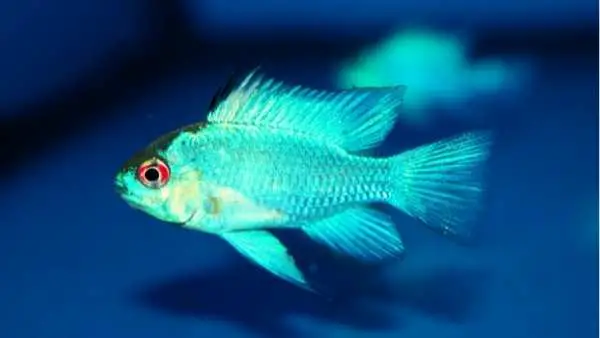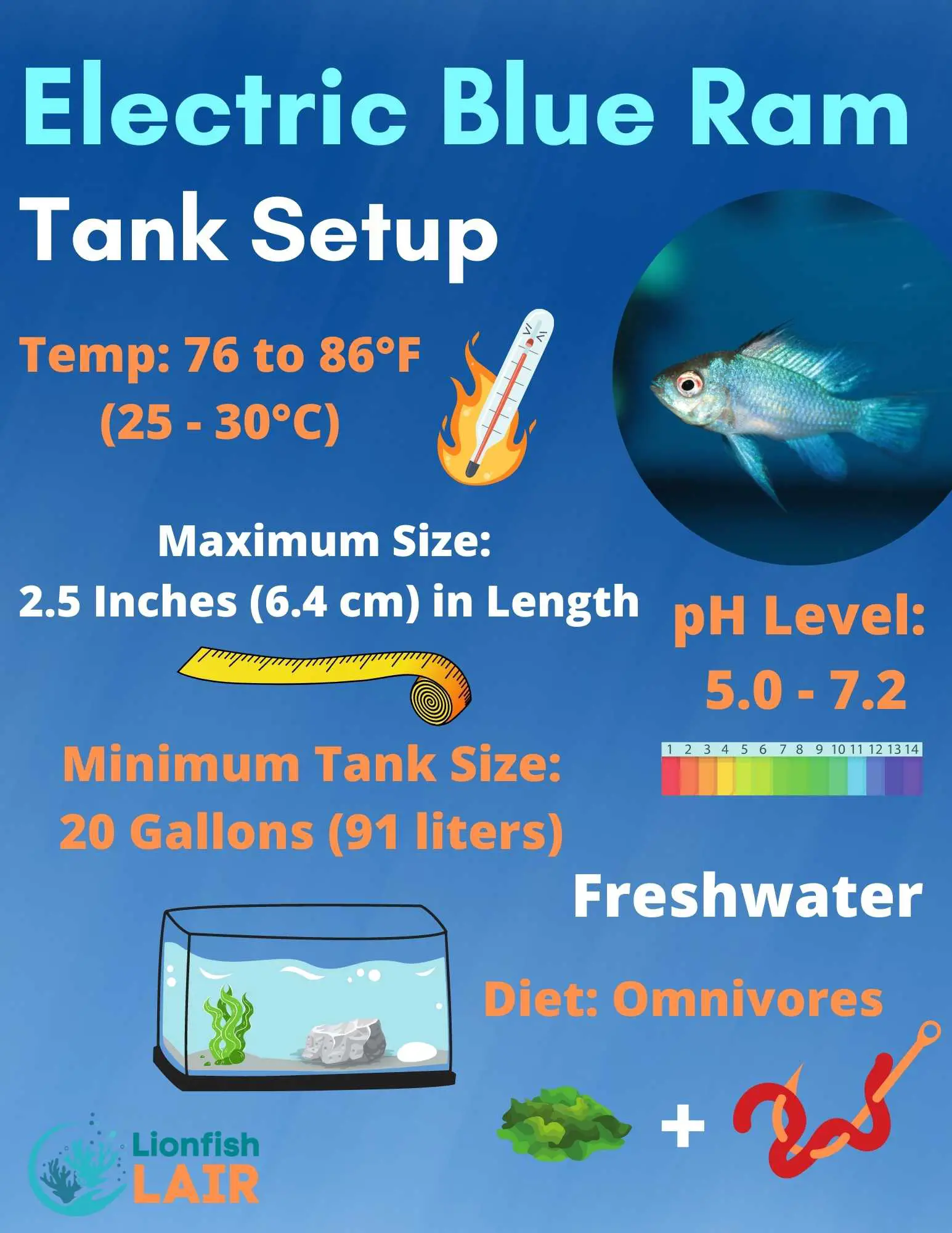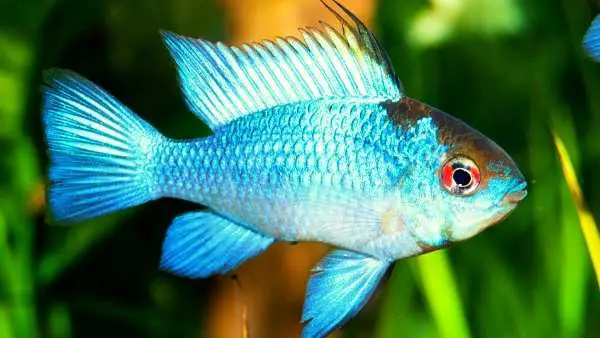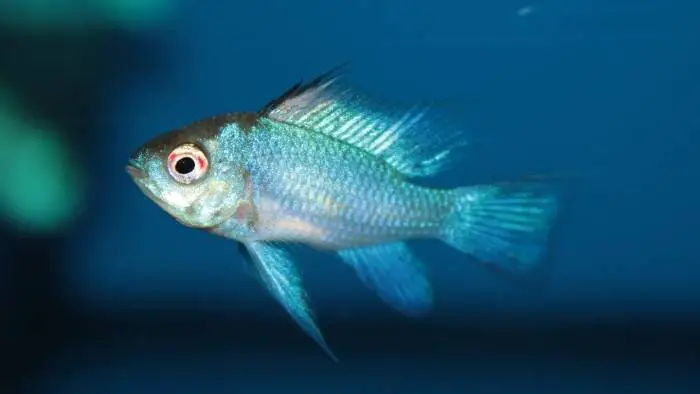The electric blue ram cichlid has been rising quickly in popularity, becoming a common addition to many experienced hobbyist's freshwater aquariums. The Electric Blue Ram, or mikrogeophagus ramirezi, is considered to be a color morph of the Common Ram and are members of the dwarf ram cichlid family.
Despite displaying a glorious array of electric blue color, and subsequently being one of the more aesthetically pleasing freshwater fish, ownership of the Electric Blue Ram is certainly no walk in the park.

They are notoriously fussy, requiring a habitat in which to live that is as similar as possible to their own natural one. This can create an awful lot of work to mimic the vegetated streams and rivers in which they would otherwise live naturally.
Electric Blue Ram General Information and Tank Requirement Overview
We would advise anyone considering taking on these majestic little beauties, to make sure you are either an experienced or well-educated owner, with commitment, and most importantly you must have time on your hands to dedicate to looking after them and making sure their fish tank environment hits the necessary requirements:
- Other names: Electric blue ram or Butterfly cichlid.
- Scientific name: Mikrogeophagus ramirezi.
- Temperature: 76 to 86°F (25 - 30°C).
- Diet: Electric blue rams are omnivores, requiring both meats and vegetables to achieve a balanced diet.
- pH level: 5.0 to 7.2.
- Maximum size: 2.5 inches (6.4 cm) in length.
- Minimum tank size: 20 Gallon (91 liters).
- Temperament: Peaceful and active.
- Coloration and pattern: Pearly white, which looks electric blue.
- Care level: Hard to care for, experienced hobbyists only.
- Lifespan: Between 5 to 20 years.
Temperament and Behavior
As far as their temperament goes, these fish can be aggressive at times, that is why it is important to purchase two as a male and female pair rather than the same sex. If you have two that are the same sex, just like the bolivian ram cichlid, expect to see a lot of fighting between them, which does not lead to a happy life for either Ram.
It can still happen however, to have pairs fight each other too. This is certainly a less common occurrence, but due to their territorial nature, opposite sex Rams have been known to beat each other up, in addition to other tank mates hailing from different species of fish. Although, it is certainly more unlikely than if they are the same sex.
Natural Habitat
These rams are freshwater fish who are native to the Orinoco River basin, situated in the South American countries of Venezuela and Colombia. Due to their unique locations, and family nature, these fish stick together and are commonly farmed.
They are typically found in steadily vegetated streams, flooded forests in the depths of South America, and Rivers such as the Orinoco River that flow for some 1,700 miles.
Electric Blue Ram Tank Setup
The fish tank setup is by far the most important aspect of owning fish, if you cannot get it right then your fish will unfortunately suffer the consequences.
Stable water parameters, paired with a plethora of plants that replicate their natural habitat will create the perfect environment for this fish.
By following the steps in this guide you will be ensuring the health and happiness of your electric blue ram.

Ideal Tank Temperature and Tank Parameters
Electric blue rams typically reside in high tropical temperatures in the wild, so, ensuring a water temperature of 76 to 86°F (25 - 30°C) is essential. By keeping the temperature consistent you are making sure they remain healthy and happy. Something to keep in mind is that when the temperatures drop, their coloration will also diminish as well as their appetite, and susceptibility to disease.
Ammonia and nitrate levels must be as close to 0ppm as possible as they are incredibly sensitive fish. Additionally, the pH level should be between 5.0 to 7.2. The most effective way of introducing these fish to a tank is by adding them to a pre-existing aquarium that shares the same temperature and parameters as them.
Size
Provided you have a healthy and happy electric blue ram that has had all of its requirements met, it should grow to a maximum of 2.5 inches (6.4 cm) in length. However, not all of these beautiful ram cichlids will grow to this length, regardless of living a healthy and stress free life! Their size will typically range between 1.5 inches and 2.5 inches and females tend to be slightly smaller than the males.
Fish Compatibility
The electric blue ram is like the rest of the Ram family with their tank mate preferences, they enjoy living with the slower moving fish, however, they aren’t too fussy with who they live with as long as they are provided stable water parameters, and an abundance of hiding places.
Some good tank mates for the electric blue ram are:
- Guppies
- Swordtails
- Mollies
- Platies
- Neon Tetras
For more detailed information on electric blue ram tank mates, make sure to check out our page dedicated to this.
Failure to look after these fish usually comes from novice hobbyists with maybe a little more ambition than experience, due to lack of an established tank, minimal hiding spots, and the wrong fish to accompany the Blue Rams.
Breeding
Breeding your electric blue rams is certainly possible, especially as they usually arrive in an opposite sex pairing to avoid too much aggression between them. They are egg-layers that will require breeding slates or flat stones to deposit their eggs on.

It is somewhat a difficult process trying to identify whether your Blue Ram is a male or female if you did not purchase an established pair. However, one way of distinguishing the two would be that the males usually have a longer dorsal fin (this isn’t always the case).
Electric Blue Ram Diet and Food
Electric blue rams are a little fussy when it comes to their food consumption, they are slow and do not fight for their share of the food most of the time, making it a little more of a strenuous process.
Diet and Feeding Tips
Here's what you need to know:
- They are omnivores, meaning that they eat both plant and animal-based foods.
- Being slow eaters means that they will not usually get the full amount of food their bodies require some of the time.
- A good diet for them would be a mix of flakes, pellets, live food, and frozen foods too.
The fish are also notoriously fussy, they are slow eaters, and almost certainly last in line for food, which is why it is vital you choose the right tank mates for them that have similar eating habits so that no fish is left hungry!

Not only this, but they tend to become stressed out quickly upon entering a new tank for the first time, which may result in a loss of appetite. If this happens and they are not accepting regular foods, try tempting them with mosquito larvae and even infusoria as they get used to being in a new aquarium.
Conclusion
In conclusion, these fish are hard work, but also incredibly rewarding, and of course undeniably beautiful with the unique color they possess and their awesome body shape!
They have been known to interact with their owners too, considerably more than the majority of other fish you buy for your freshwater community, having fish with personality is so crucial in running a successful aquarium.
An example of their interaction would be when placing your hands in a tank (which to be honest, is not advised), they tend to swim over and pay your hands some attention without biting or any of the bad stuff.
They can, however, be aggressive towards other rams, but they are certainly not with humans and display a lot of affection. They are also very inquisitive and will often be the first to greet you when you rock up to your aquarium, which is quite endearing.

